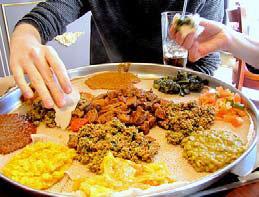
The first time they went to an Ethiopian restaurant they didn’t know what to expect. She was enamored with the bread’s spongy texture. He was thrilled to find this Middle Eastern food did not need cutlery. Happily, they dubbed this ethnic food a favorite.
That’s how two members of my family described their first visit to a Washington, D.C. Ethiopian restaurant. Their rave reviews convinced me that I would have to try it. From my first bite in a New York City restaurant some time later, I knew that I would be dining on Ethiopian cuisine every chance I had.
Since then, I have had several chances to enjoy this extraordinary food when Abay Ethiopian Cuisine opened in Pittsburgh, PA, near my hometown.
Jamie Wallace, owner of Abay, gave an inside look at the unique Ethiopian dishes.
“I would describe it as looking similar to certain types of Indian food, but not necessarily tasting like it, due to the difference in the spices used,” he said. “Spicy Ethiopian dishes typically contain berbere or mitmita. These spice blends are unique to Ethiopia. Although the food can seem a bit distinctive initially, once one has a chance to try a variety, he or she typically realizes there are flavors in the cuisine that are familiar. I view Ethiopian food as healthy, flavorful, comfort food.”
I could not agree more. One of my favorite Ethiopian dishes is injera, or that spongy bread that was a delight to my cousin.
“Where other African countries might have rice or fufu as a staple, Ethiopia has injera,” Jamie said. “This Ethiopian flatbread is made from teff, which is an extremely nutritious whole grain indigenous to Ethiopia. Ethiopian food is traditionally served in a communal style. Injera is placed on a large platter. Entrees are placed on top of the injera. Additional injera is provided on the side. The common way to eat it is to tear off pieces of the thin, crepe-like injera bread and use it to scoop the food.”
This communal-style meal offers diners a great way to try various dishes. My husband and I usually opt for a vegetarian dish when we visit Abay. It typically includes beans, greens, split peas, and cabbage. These veggies taste nothing like the ones served in American restaurants, smothered in butter and topped with cheese. Instead, they are spiced with delicious herbs and sauces.
Jamie says, “The fact that the food is slow-cooked, includes fresh ingredients and has fantastic herbs and spices means one can yield phenomenal flavors from all of the dishes, including vegan ones. Because Ethiopia has had a fasting culture for thousands of years, Ethiopian vegan, and vegetarian recipes have had a long time to be perfected. Thus, the vegan and vegetarian dishes taste good in their own right, as opposed to merely tasting like something where the meat was removed from the dish to make it vegetarian.”
A visit to an Ethiopian restaurant is not only meant for meatless lovers however, slow-cooked beef and spicy chicken are just a couple types of the meats on an Ethiopian menu.
Jamie suggests, “Because the concept of the food is to have a variety (similar in that sense to tapas), I always encourage people to try a combination platter. Bear in mind, there are dishes in the cuisine that can suit everyone’s palate.”
Every time I visit an Ethiopian restaurant, I feel as if I get a glimpse of a 2,000-year-old nation, believed to be one of the oldest in the world. I delight in eating injera topped with flavorful fare, and I savor the experience.
